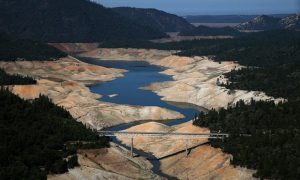
From Cal-EPA
From record temperatures to proliferating wildfires and rising seas, California is already feeling the significant and growing effects of climate change, according to a new report that tracks 36 indicators of climate change and its impacts on the state.
The report documents the growing number of extreme weather-related events in recent years, such as the devastating 2017 wildfires and the record-setting 2012-16 drought. Some of the long-term warming trends underlying these events, including the rise in average temperatures and the number of extremely hot days and nights, have accelerated in recent decades, the report shows.
The report also tracks a variety of other climate change indicators: the declining snowpack and dramatic retreat of glaciers in the Sierra Nevada, unprecedented tree mortality in California forests, a rise in ocean temperatures off the California coast, and the shifting ranges of many species of California plants and animals. These impacts are similar to those that are occurring globally.
“As California works to both fight climate change and adapt to it, it is critical that we understand the dramatic impacts climate change is already having in our state,” said California Secretary for Environmental Protection Matthew Rodriquez. “California’s climate leadership is unquestioned, and this report builds on the essential scientific foundation that informs our efforts to respond to climate change.”
CalEPA’s Office of Environmental Health Hazard Assessment (OEHHA) compiled the 36 indicators of climate change, drawing upon monitoring data from throughout the state and a wide variety of research studies carried out by state and federal agencies, universities and research institutions.
“These indicators illustrate in stark terms how climate change is affecting our state, and the growing threat climate change poses to our future,” said OEHHA Director Dr. Lauren Zeise. “This report demonstrates the value of California’s extensive research and monitoring efforts, and is a valuable resource for state and local policymakers addressing critical climate adaptation and mitigation needs.”
One of the more positive outcomes discussed in the report is that despite an increase in the state’s population and economic output, California’s pioneering policies designed to curb emissions of greenhouse gases (GHGs) have led to an overall decline in emissions as well as decreased emissions per capita and per dollar of its gross state product.
Additional key findings of the report include:
- Temperature: Average air temperatures have increased throughout the state since 1895, with temperatures increasing at a faster rate since the mid-1970s. The last four years were the hottest on record, with 2014 being the warmest, followed by 2015, 2017, and 2016. Nighttime temperatures have been rising faster than daytime temperatures.
- Wildfires: The five largest fire years since 1950 occurred in 2006, 2007, 2008, 2012 and 2015. Preliminary data suggest that 2017, which included the deadliest and most destructive wildfires in state history (Sonoma and Napa counties) and the largest wildfire in state history (Thomas Fire in Ventura and Santa Barbara counties), will rank as the second largest fire year in terms of total acreage.
- Drought: California is becoming drier, with unprecedented dry years in 2014 and 2015. The recent drought from 2012 to 2016 was the most extreme since instrumental records began.
- Sierra Nevada Snowmelt: The fraction of snowmelt runoff into the Sacramento River between April and July relative to total year-round runoff has declined, leading to less water available during the summer to meet the state’s needs.
- Species Migration: Pine forests now occupy less area statewide, while in certain parts of the state, oaks cover larger areas. About 75 percent of the small mammal species and over 80 percent of the bird species surveyed in the Sierra Nevada region have shifted ranges.
- Agriculture: In parts of the Central Valley, certain fruits and nuts (prunes and one walnut variety) are maturing more quickly with warming temperatures, leading to earlier harvests. Shorter maturation times generally lead to smaller fruits and nuts, potentially causing a significant loss
of revenue for growers and suppliers.
In addition, the report highlights a variety of “emerging climate change issues” that appear to be influenced by climate change but the link has not yet been conclusively established. These include a reduction in coastal and Central Valley fog, an increase in harmful algal blooms, and a rise in invasive agricultural pests. Additional data or further analyses will be needed to determine the extent to which climate change plays a role.
The report is one of two major state research efforts looking at climate change impacts in California. While the indicators report documents and measures impacts that have already occurred, another series of reports, California’s Climate Change Assessments, builds on these observations to make projections about future impacts that can inform state adaptation strategies. California is one of the few states to compile its own series of comprehensive reports on the impacts of climate change.
The full indicators report and a 15-pages summary are available at oehha.ca.gov/climate-change/document/indicators-climate-change-california.



One Response to Impacts of climate change in California significant and increasingly stark